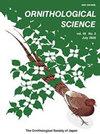Egg Pattern Mimicry in Avian Brood Parasitism Assessed Using Local Image Descriptors and Human-Eyes
IF 0.3
4区 生物学
Q4 ORNITHOLOGY
引用次数: 0
Abstract
Abstract Egg pattern plays a critical role in avian brood parasitism where a brood parasite exploits a host's parental care by laying eggs in host nests relying on the host to rear the parasitic egg(s). It has been demonstrated that many hosts have evolved an ability to recognize and reject parasitic eggs, based on differences in egg patterns, as a defense against brood parasitism, while some parasites have evolved egg mimicry to counter the host defense. Egg pattern is a complex phenotype and its quantitative evaluation has been a focus of much research. In this paper, we propose a novel method for quantifying an egg pattern and assessing the degree of egg pattern mimicry—a measure of the similarity of a parasite egg to host eggs. Our approach is based on image analysis focused on local binary pattern (LBP) and its variant completed local binary pattern (CLBP) that captures the local structure of a pattern in an image. We compare the results obtained by LBP and CLBP with human-eye evaluation, a classical method widely used in previous studies. Both LBP and CLBP can successfully assess the similarity in egg pattern that is positively correlated with human-eye scores with a high accuracy rate. LBP tends to perform better than CLBP at small scales while CLBP performs better for a wide range of larger scales. Our method can be an effective alternative means of assessing the degree of egg pattern mimicry objectively, providing a useful tool for biologists studying avian brood parasitism. Many bird species have specific eggshell patterns (e.g. spots, blotches, lines) and it has been suggested that these patterns are an important functional trait, such as for camouflage against predators. We propose our method as a useful and objective tool for assessing egg patterns.用局部图像描述子和人眼评估禽类寄生虫的蛋型模拟
卵型在鸟类幼巢寄生中起着至关重要的作用,幼巢寄生虫利用寄主的亲代照顾,在寄主的巢中产卵,依靠寄主抚养寄生卵。已经证明,许多寄主已经进化出一种识别和拒绝寄生卵的能力,基于卵模式的差异,作为对幼虫寄生的防御,而一些寄主已经进化出卵模仿来对抗寄主的防御。卵型是一种复杂的表型,其定量评价一直是研究的热点。在本文中,我们提出了一种新的方法来量化卵模式和评估卵模式模仿程度-一种衡量寄生虫卵与宿主卵相似性的方法。我们的方法基于图像分析,重点关注局部二值模式(LBP)及其变体完全局部二值模式(CLBP),该模式捕获图像中模式的局部结构。我们将LBP和CLBP得到的结果与以往研究中广泛使用的经典人眼评价方法进行了比较。LBP和CLBP均能成功评估卵型相似性,且与人眼评分呈正相关,准确率较高。LBP在小尺度上的表现优于CLBP,而CLBP在大范围内的表现优于CLBP。该方法可作为一种客观评价鸟类卵型模仿程度的有效替代手段,为生物学家研究雏鸟寄生提供了有益的工具。许多鸟类都有特定的蛋壳图案(如斑点、斑点、线条),有人认为这些图案是一种重要的功能特征,例如用于伪装捕食者。我们提出我们的方法作为一个有用的和客观的工具来评估卵子的模式。
本文章由计算机程序翻译,如有差异,请以英文原文为准。
求助全文
约1分钟内获得全文
求助全文
来源期刊

Ornithological Science
ORNITHOLOGY-
CiteScore
1.20
自引率
0.00%
发文量
26
审稿时长
>12 weeks
期刊介绍:
Ornithological Science publishes reviews, original articles, short communications and comments covering all aspects of ornithology. Manuscripts are judged on the basis of their contribution of original data and ideas or interpretation. All articles are peer-reviewed by at least two researchers expert in the field of the submitted paper. Manuscript are edited where necessary for clarify and economy. Ornithological Science aims to publish as rapidly as is consistent with the requirements of peer-review and normal publishing constraints.
 求助内容:
求助内容: 应助结果提醒方式:
应助结果提醒方式:


